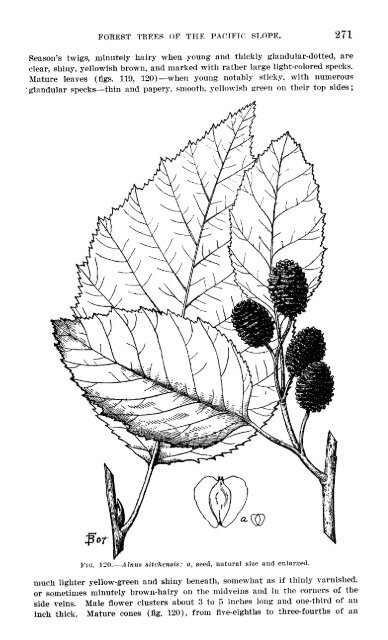De I. VNER VEW D Forest Trees of the Pacific Slope
De I. VNER VEW D Forest Trees of the Pacific Slope
De I. VNER VEW D Forest Trees of the Pacific Slope
Create successful ePaper yourself
Turn your PDF publications into a flip-book with our unique Google optimized e-Paper software.
132 FOREST TREES OF THE PACIFIC SLOPE.<br />
years old <strong>of</strong>ten bear cones, but seed is produced mainly by older and mature trees. Seed<br />
production appears to increase with age and to be maintained to great age. Seed <strong>of</strong> low<br />
germination (40 to 50 per cent), and <strong>of</strong> very transient vitality; much <strong>of</strong> it destroyed by<br />
an insect and eaten by squirrels. Seed germinates freely and seedlings grow well on any<br />
moist humus or mineral soil in <strong>the</strong> open or in moderate shade; seedlings do not thrive<br />
In shade <strong>of</strong> mo<strong>the</strong>r trees. Openings made near seed trees are readily restocked.<br />
Red Fir.<br />
Abies magnifica Murray.<br />
DISTINOGUISHING CHARACTERISTICS.<br />
The common name <strong>of</strong> red fir is appropriately chosen in reference to <strong>the</strong> deep<br />
red-brown bark which it almost invariably has throughout its range. It is a<br />
stately tree when fully grown, commonly from 125 to 175 feet high, very exceptionally<br />
200 feet or more, and from 30 to 50 inches in diameter; trees from 60<br />
to 80 inches in diameter are ra<strong>the</strong>r rare. Much larger trees are said to have<br />
been found, but <strong>the</strong> writer has never seen <strong>the</strong>m. At high elevations, much<br />
exposed to heavy winds, it is very <strong>of</strong>ten from 40 to 80 feet high and from 20 to<br />
30 inches in diameter, or smaller. In close stands <strong>the</strong> straight, slightly tapering<br />
trunks are clear <strong>of</strong> branches for 60 or 80 feet or more. On high exposed slopes,<br />
smaller trees are <strong>of</strong>ten conspicuously bent down <strong>the</strong> slope at <strong>the</strong>ir base, as a<br />
result <strong>of</strong> heavy snows which yearly bend <strong>the</strong> seedlings to <strong>the</strong> ground. Their<br />
struggle to become upright with each year's growth never wholly rids <strong>the</strong>m <strong>of</strong><br />
<strong>the</strong> mark <strong>of</strong> early vicissitudes. The crown <strong>of</strong> old forest grown trees is a short,<br />
very narrow, round-topped cone, sometimes almost cylindrical. The short<br />
branches droop except at <strong>the</strong> top <strong>of</strong> <strong>the</strong> crown, where <strong>the</strong>y trend upward. It<br />
has an open head, due to <strong>the</strong> distances between <strong>the</strong> regular whorls <strong>of</strong><br />
branches. Only in <strong>the</strong> densest stands are medium-sized trees clear <strong>of</strong> branches<br />
for half or more <strong>of</strong> <strong>the</strong>ir length. In <strong>the</strong> high, fairly dense slope forests many<br />
trees bear straggling branches nearly to <strong>the</strong> ground. Here, too, <strong>the</strong> brittle tops<br />
are <strong>of</strong>ten broken <strong>of</strong>f by wind, when <strong>the</strong> lost member is replaced by <strong>the</strong> upward<br />
growth <strong>of</strong> one or two side branches, which soon assume <strong>the</strong> form and place <strong>of</strong><br />
leaders. Broken and repaired crowns <strong>of</strong> this type are familiar sights on windswept<br />
slopes inhabited by this fir. Young trees (30 to 50 years old and as many<br />
feet high) have narrow, cylindrical, sharp-pointed crowns, touching <strong>the</strong> ground.<br />
All <strong>of</strong> <strong>the</strong> regular groups <strong>of</strong> branches, except <strong>the</strong> topmost, sweep down and<br />
upward at <strong>the</strong>ir ends in graceful curves, presenting a form which is unsurpassed<br />
in beauty and symmetry by any o<strong>the</strong>r <strong>of</strong> our conifers. The bark, smooth<br />
and conspicuously chalky white on young trees and on <strong>the</strong> upper stem and<br />
branches <strong>of</strong> old trees, is from 2 to 3 inches thick on large trees; its hard, rough,<br />
deep furrows and narrow, rounded ridges are very distinctive. The latter are<br />
irregularly divided by diagonal furrows, which give a peculiar diagonal and<br />
vertical or zig-zag trend to <strong>the</strong> ridges. No o<strong>the</strong>r tree in <strong>the</strong> habitat <strong>of</strong> this fir<br />
has bark in any way similar.<br />
The dense foliage is dark blue-green, with a whitish tinge; new leaves <strong>of</strong> <strong>the</strong><br />
season are much lighter green and conspicuously whitened. The leaves are 4angled<br />
with nearly equal sides, <strong>the</strong> angle on <strong>the</strong> upper sides <strong>of</strong> <strong>the</strong> leaves being<br />
rounded. Leaves <strong>of</strong> <strong>the</strong> lower branches (fig. 52) are flatter than those from<br />
o<strong>the</strong>r parts <strong>of</strong> <strong>the</strong> crown. They are bent from <strong>the</strong> lower side <strong>of</strong> <strong>the</strong> branches<br />
so that <strong>the</strong>y appear to grow from <strong>the</strong> top <strong>of</strong> <strong>the</strong> branch, mainly in two dense<br />
upright lines; all are more or less curved. Lower leaves, from three-fourths<br />
inch to about 1* inches long, are blunt and wider at <strong>the</strong>ir ends than at <strong>the</strong>ir<br />
bases. Leaves <strong>of</strong> <strong>the</strong> upper crown branches (fig. 53), five-eighths inch to about<br />
1j inches long, are most strongly 4-sided, stouter than those below, conspicu-

















